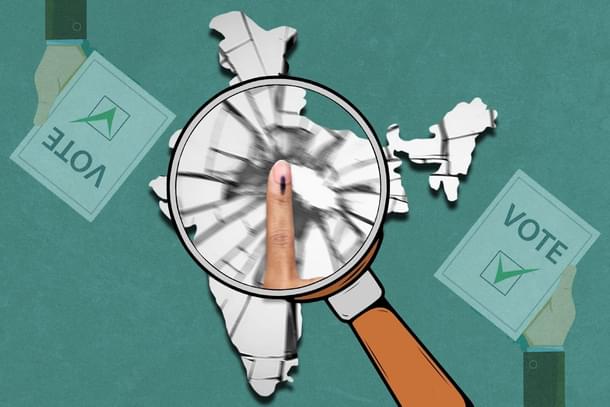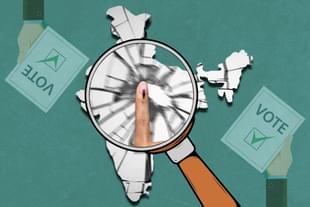Politics
India's Parliament Is Severely Understaffed To Deal With Issues — There's A Need To Fix That First And Foremost
Sharan Setty
Dec 23, 2024, 08:36 PM | Updated 08:36 PM IST
Save & read from anywhere!
Bookmark stories for easy access on any device or the Swarajya app.


In 2026, India will be undertaking a delimitation exercise, pending for over five decades. As the Parliament votes to introduce the 'one nation, one election' bill, now is a good time to revisit the debates surrounding the ayes and the nays of the delimitation exercise and have a roadmap prepared to build consensus for reforms.
What Is Delimitation?
India's delimitation exercise will be a significant constitutional process aimed at redrawing the boundaries of parliamentary and assembly constituencies based on the latest census data.
The constitutional basis for this exercise is found in Articles 82 and 170 of the Indian Constitution, which mandate that the Parliament must readjust the allocation of seats in the Lok Sabha and state legislative assemblies after each census.
The Delimitation Act of 2002 established the framework for this process, allowing for the formation of a Delimitation Commission to oversee the redistricting efforts.
Delimitation is necessary to ensure equal representation in line with population changes, thereby adhering to the principle of one vote, one value.
The first Delimitation Commission was established in 1952, followed by subsequent commissions in 1962 and 1973, each tasked with redefining constituency boundaries based on census data.
Historically, delimitation was conducted regularly until it was frozen by the 42nd Amendment in 1976, which postponed any adjustments until 2000.
This freeze was extended by the 84th Amendment in 2002, until after the first census post-2026, primarily to encourage population control measures among states.
The last comprehensive delimitation occurred using data from the 2001 census, leading to significant disparities in constituency sizes due to uneven population growth across regions.
The upcoming exercise aims to address these disparities and realign representation according to current demographic realities.
Fears Down South
While it is true that the delimitation exercise, if conducted purely on the basis of population growth, will disincentivise states in the south, west, and the northeast, reports indicate that the government may not be keen on upsetting anyone in particular.
The fear of opposition leaders and aligning experts that the Bharatiya Janata Party (BJP)-led National Democratic Alliance (NDA) may push for more seats in the Hindi belt — Madhya Pradesh, Uttar Pradesh, Rajasthan, and Bihar — may not hold water.
The BJP's Concern
In the southern parts of the country, the BJP is still in its infancy. While it has been able to form governments in states like Karnataka, its presence is almost ignorable in Andhra Pradesh, Kerala, and Tamil Nadu. With the upsets in Telangana and Karnataka assembly elections, morale is certainly down.
For this reason, the BJP has been dependent on its allies, even during the general election, and also why the Janata Dal (Secular) and Telugu Desam Party (TDP) have remained among their most reliable allies.
Upsetting these key allies down south won't augur well for the party.
Game Over for Regional Players?
One fear that the regional parties, particularly in the south, have is the possible diminishing power and an upset in the balance.
Parties like the Dravida Munnetra Kazhagam (DMK), Communist Party of India (Marxist), All India Anna Dravida Munnetra Kazhagam (AIADMK), Bharat Rashtra Samithi (BRS), and Telugu Desam Party (TDP) might feel uncomfortable with an arrangement where national parties directly stand to benefit with an initiatives like delimitation and 'one nation, one election', which is currently tabled in the Lok Sabha for discussion.
However, there have been many instances in the past where polling for state assemblies and the Parliament were held on the same day, but the results were astoundingly different — the TDP scored a win over others in Andhra Pradesh, the BJD won against the formidable election machinery of the BJP in Odisha, and so on.
Introducing Equity
With this in mind, several solutions have been proposed in the past. For instance, the paper by Alistair McMillan from two decades ago serves the same lesson. If over- and under-representation in Lok Sabha were calculated on the basis of the 2001 population figures, the lower house was short by 104 seats; that is, the Lok Sabha should have had a total strength of 647 Lok Sabha MPs.
Milan Vaishnav and Jamie Hintson, writing for the Carnegie Endowment for International Peace, argue that the expansion of the house is the more logical thing to do rather than reapportioning the existing seats.
Their logic: states can question any arrangement where their seats are taken away from their block and reduces their power and say in matters, both local and national.
If Lok Sabha were not to lose representation, its composition has to be pushed up to 850-odd seats — large enough to ensure no state loses representation.
If and when this is done, India will perhaps have the biggest strength of any lower house in a democratic country in the world.
Urban India Deserves a Say
Educated, qualified Indians have a big impact on politics, except in India. And that's a tragedy. You have brown people making waves in global politics, whether it is Canada or the United States (US), the United Kingdom (UK) or Australia. Unless we remove the barrier of money, muscle, and caste equation in politics, it will never be a fair field for efficient administrators to come into the system.
This gets reflected elsewhere — the film industry, the corporate world, the media, the judiciary, and the press. If you belong to a family, you have a place in the system. The middle class is heavily taxed, faces the threat of inflation every now and then, and is burdened by heavy interest rates if they aspire to a different lifestyle.
That is the reason many talented individuals leave the country, hoping to seek better opportunities in a system that is designed to treat everyone equally, at least in principle and practice.
But why are we not able to achieve this?
A smaller say for urban India and low voting rates among the educated classes.
In this context, the long-overdue delimitation exercise must navigate the delicate balance between two competing constitutional principles: formal equality in voting and the tenets of federalism.
Due to the freeze on delimitation, some urban constituencies have seen their electorate sizes swell disproportionately.
As a result, the value of an individual’s vote in these densely populated areas does not hold the same weight as that of a citizen voting in less populated constituencies. This disparity highlights the urgent need for a fair and equitable redrawing of electoral boundaries.
For instance, a city like Bengaluru, with a population of nearly 14 million, has just four representatives in the Lok Sabha, whereas it must ideally have eight to 10 purely based on numbers.
This is true in the Pune and Surat cases too, with the former having a population of 5,751,182 but only one Lok Sabha seat out of the total 48 in Maharashtra.
Surat, having a 90 per cent urban population, has only nine assembly constituencies in the Gujarat legislative assembly, adding up to 5 per cent of the strength. If we are to take into account the migration that has taken place to urban clusters in the last 10-12 years, the difference will be staggering as compared to the figures the current research based on the 2011 census numbers are projecting.
Urban local bodies are disempowered too, with cities starving for funding. They are either dependent on the Centre or the state to receive autonomy, direction, and funding. They are not equipped to address urban concerns on their own — the reason why cities like Bengaluru are in dire straits. Unless these numbers are reconfigured and represented adequately, the state of affairs will remain the same.
Advantages and Disadvantages
The upcoming delimitation process in India brings with it a mix of exciting possibilities and serious concerns that could reshape the political landscape.
On the positive side, urban voters may find their voices amplified in governance. This shift could pave the way for a new generation of leaders, including more young people.
Moreover, by streamlining electoral processes, this exercise could help cut down on the massive election-related expenses that often run into thousands of crores.
However, there are pitfalls to avoid. Without clear communication, states in the south and east could slip into a feeling of marginalisation as northern states gain more seats due to higher population growth.
Such an imbalance might not only deepen existing disparities but also fuel regional tensions.
As we approach this critical juncture, it's essential to find a way to balance equitable representation at the level of individual constituencies with that at the level of states.
Sharan Setty (Sharan K A) is an Associate Editor at Swarajya. He tweets at @sharansetty2.




